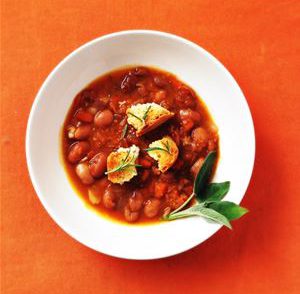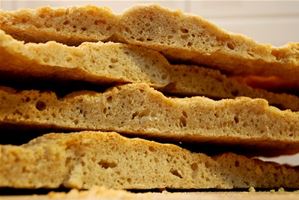Aphrodisiacal,
addictive, adds punch to any dish, has wonderful digestive properties? I needed
no further convincing on a recent trip to Thailand to try chilli in my morning
omelette; green papaya salad with toasted cashews, lime juice, fresh crunchy
green beans and fresh sliced red hot chilli for lunch; pounded lemongrass and
fresh chilli over crushed ice, vodka and a lime sugar syrup for a poolside
cocktail. I found myself waking up wondering which chilli snacks could add fire
to my mornings, afternoons and evenings.
When a human eats chilli, the body gets a shock from the heat explosion
and sensations of swelling in the mouth and around the lips, so the brain gets
a ‘danger’ message and sends out endorphins to help us recover. The chilli hit
is an actual shock, a physical assault: our hearts race, then the endorphins
kick in and they release a pleasant feeling as we recover from the shock. So we
continue to eat chilli, and as our levels of tolerance rise, our bodies send
out less endorphins, so we up the intake just to get the rush.
Although
Tuscany and Thailand have very few similarities on the food front, chilli, or peperoncino, is something they do have in common, with Italy’s first brought to
Europe from the Americas by Christopher Columbus. In Italy, peperoncino is generally used much more sparingly than in Thailand (except if you
are in Calabria, where it is found in almost every dish and where you can even
visit the Peperoncino Museum; see www.peperoncino.org), and it goes by an
entirely different name in Florence than it does elsewhere in Italy.
In
fact, the word for chilli pepper was one of the first Florentinisms I learned. A few years back, while fine-tuning Tuscan dishes with the
head chef of the Cantinetta Antinori in Florence, I asked for peperoncino to prepare a Tuscan dish. The verbal negative and puzzled expression
surprised me. ‘Perhaps he doesn’t use chilli in his kitchen,’ I thought. ‘How
strange.’ Yet foraging in his pantry, I found a huge jar of beautiful
mailbox-red, lacquer-shiny small, dried chillies and assumed my request had
been lost in translation. When I showed him the jar of red delights, I learned
that the Italian peperoncino is the Tuscan zenzero. So, while zenzero means ‘ginger’ in
Italian, it means ‘chilli’ in Florentine kitchens.
However,
whether you call it chilli, peperoncino or zenzero, it adds depth to any dish. It is
also addictive.
So
when trying to think of something warming to get us through the last of the
cold days before spring starts hinting of summer, I chose an old Tuscan
favourite with the added kick of Tuscan zenzero.
Here is my version of the classic pasta e fagioli, a dish found as far north as Venice and as far south as Naples, with
regional differences (of course). As with most seemingly simple dishes, it
requires a few more ingredients and a few more steps. And while it won’t warm
you up as much as Thai food and swims in the Indian Ocean, if you are game to
add enough zenzero, it will give you those
pleasure-inducing endorphines.
Buon
appetito!
PASTA E
FAGIOLI (pasta with beans)
INGREDIENTS
STAGE
1
250g
dried fagioli cannellini (cannellini beans)
3 cloves
garlic
zenzero
(chilli) to taste (Tuscan dried reds)
Tuscan
extra-virgin olive oil
Fresh
rosemary and sage
STAGE
2
50g
smoked pancetta
1 clove
garlic
2 ripe
tomatoes
Crust of parmigiano (parmesan cheese) if you have one
CROSTINI:
Pane
raffermo (yesterday’s leftover bread)
Tuscan
extra-virgin olive oil, salt, chilli flakes
PASTA:
200g of
dried pici pasta from Siena; these will be broken into short pieces before
cooking
METHOD
1. Soak the
fagioli cannellini overnight in cold water.
2. Wash the
beans and cover with fresh water in a soup pot. Throw in a small bunch of sage
leaves, three garlic cloves in camicia (without peeling the cloves; literally meaning
‘in its shirt’), a couple of branches of fresh rosemary, and a good lashing of
Tuscan extra-virgin olive oil.
3. Bring to
a boil and simmer on a very low flame at the side of the stove for 2 to 3
hours, topping with water when necessary.
4. Remove
from heat and separate the beans from the cooking liquid, keeping both. Squeeze
the garlic out of its shirt and into the beans; pick the leaves from the
rosemary and sage and discard the stalks.
5. Take the
smoked pancetta,
cut into thick ribbons and then into narrow strips. Heat a tablespoon of Tuscan
extra-virgin olive oil in a heavy-based pan and throw in the garlic clove whole
and peeled, with as much crushed dried chilli as you dare, seeds and all, and
toast in the oil for a couple of minutes. Add the pancetta and cook until the fat becomes
transparent. Add a crust of parmigiano if you have one. This will soften and add
flavour to the soup.
6. Dice up the two ripe tomatoes and add these to the pan
along with the fagioli cannellini with
the herbs, topping up again with the reserved cooking liquid. Bring back to a
boil and simmer for 20 minutes, set the parmesan crust aside then blend the
entire mixture. This should now be a dense puree of beans, darkened somewhat
with the addition of sautéing and from the rich red of the tomato.
CROSTINI
Roughly cut
up some pane raffermo into bits that are a little larger than a sugar cube. Toss in a bowl
with salt, chilli flakes and olive oil; toast in the oven until it is a crispy
crunchy golden brown and set aside.
PASTA
Bring to a
boil some water salted with rock salt, break up the flour-and-water-made pici pasta into small
pieces, half-cook then drain. Finish the cooking process by simmering the pasta
in the bean puree, adding more water if necessary.
Taste for
seasoning, serve in rustic ceramic bowls and finish with crostini and more extra-virgin olive oil
from Tuscany.
WINE
MATCH
A good
young Chianti Classico is a great accompaniment to this heart-warming primo
piatto. I recommend
Castellare di Castellina Chianti Classico DOCG 2008.







